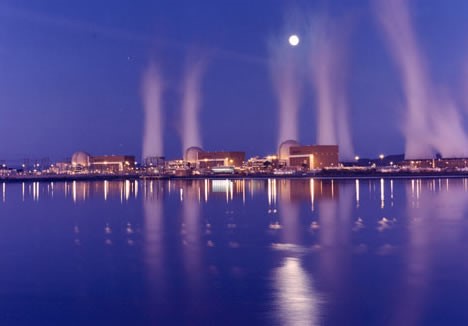Will Climate Change Impact Nuclear Energy in the Southwest?
Author: Britain Eakin
With the Fukushima nuclear accident still fresh on people’s minds, and the Obama Administration set to vamp up the nuclear power option, now is a good time to reevaluate the viability of nuclear energy, particularly in relation to climate change.
In the process of generating nuclear-based electricity, large amounts of cool water are needed to maintain safe temperatures in the reactors. This is why the overwhelming majority of nuclear power plants are located adjacent to bodies of water; they divert water from these sources for cooling, and then release it back into the same sources. Climate change has the potential to significantly impact water availability and water temperatures, especially here in the Southwest; this raises the question of whether nuclear energy production could be affected by climate change as well.
Consider that in the summer of 2003, France’s nuclear power industry was impacted by the extreme heat wave and ensuing drought that covered much of Europe. Seventeen of France’s nuclear reactors used for energy production had to be shut down or slowed down. This happened because water levels in some rivers—the water source for France’s nuclear power plants — plummeted. Additionally, water temperatures in some of the rivers rose significantly. Since environmental regulations limit the amount of heated water that nuclear power plants can release in order to protect living organisms, the warmer river temperatures during the 2003 heat wave limited the amount of heated water the nuclear plants could release, forcing some of the nuclear reactors to drastically reduce their energy output.
A question posed recently by Dr. Jonathan Overpeck piqued my curiosity. Could the energy crisis that emerged in France during the summer of 2003 happen to the Palo Verde Nuclear Generating Station just outside of Phoenix in Wintersburg, Arizona? The forecast for climate change in the Southwest indicates that temperatures will get hotter and the climate will get drier. Is it a good idea to rely on nuclear power in an already hot and dry desert climate?
Palo Verde Nuclear Generating Station is the largest nuclear electric plant in the U.S., and supplies 4 million residents in California, Arizona, New Mexico and Texas. It is responsible for 25 percent of Arizona’s electricity generation. However, it operates very differently than conventional nuclear power plants, and because of that, climate change might not impact it as severely as conventional plants, at least not right away.

The Palo Verde Nuclear Generating Station, located in Wintersburg, AZ, is the largest nuclear electric plant in the U.S., and supplies 4 million residents in California, Arizona, New Mexico and Texas. Photo: AZ DEMA
Palo Verde is the only nuclear electric plant in the world that uses effluent water for cooling, and is also the only nuclear power plant in the world that is not situated next to an naturally occuring body of water. Palo Verde buys wastewater from the nearby cities of Glendale, Mesa, Phoenix, Scottsdale and Tempe, and from Arizona Public Service and the Salt River Project to use for cooling. It also has its own wastewater treatment plant where the wastewater is piped, treated and then stored in an 80-acre reservoir to use for cooling. Because the reservoir is not an naturally occurring body of water, the environment-based temperature regulations do not apply.
According to Dr. Sheldon Trubatch, managing member of The Regulatory Strategy Group, L.L.C., Arizona would have to undergo a very long, sustained drought, to the point where people would stop flushing their toilets and running water in their sinks—i.e., generating wastewater—for the impacts of climate change to affect production at Palo Verde. It seems the primary question to ask is, what is the likelihood that the Phoenix area could experience a long enough drought to cause Palo Verde to shut down or reduce its output?

